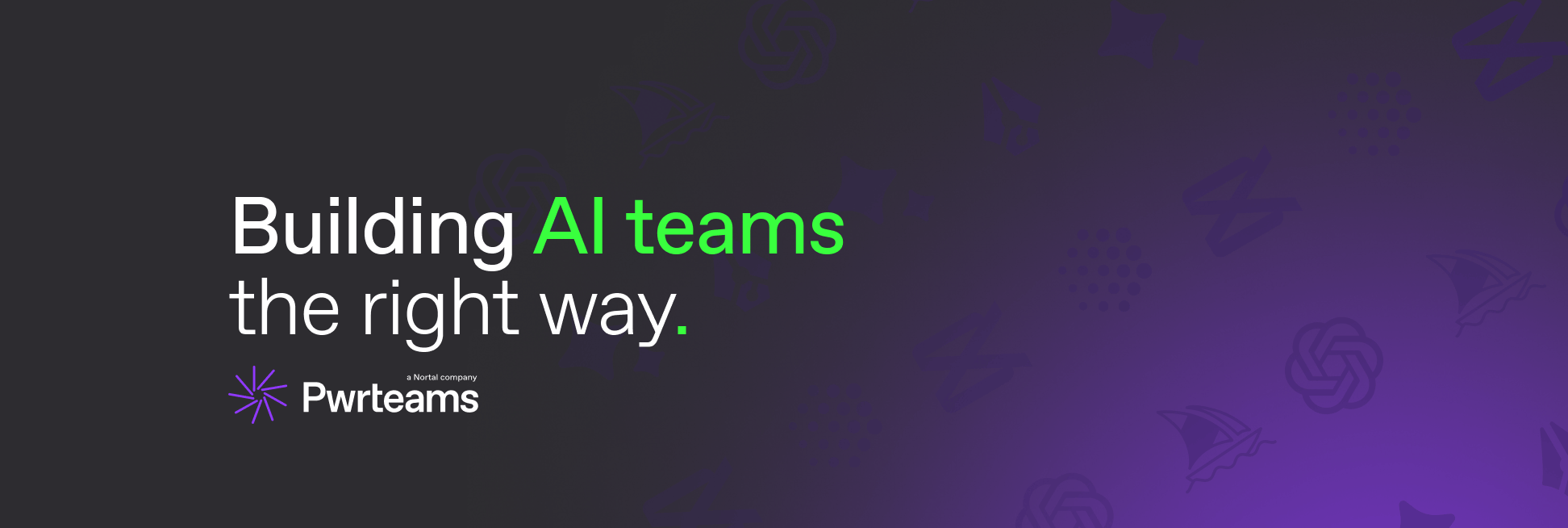Building AI teams: strategies for growth, culture, and scalability


AI is reshaping how teams think, work, and build.
From healthcare to finance, businesses are using AI to solve complex problems, create efficiencies, and unlock new opportunities. But the road to successful AI adoption is not without its bumps. Many AI projects fail to deliver on their promises, often due to unrealistic expectations, slow adoption rates, and the complexities of integrating AI into existing workflows.
The shift to AI isn’t just about faster processing or smarter algorithms - it’s redefining the way teams function. Much like the transition from on-premise to cloud computing reshaped product development, AI will fundamentally alter how teams collaborate, iterate, and execute. Traditionally, product development followed a structured process with clear handoffs: PRDs, wireframes, approvals. AI disrupts this.
Instead of lengthy documentation cycles, AI-native teams use AI to generate wireframes, automate A/B testing, and analyse user behaviour in real-time, enabling them to make product decisions based on live insights rather than guesswork. This shift reduces ambiguity, accelerates decision-making, and allows for more real-world experimentation. Engineers can take on product management tasks, and product managers can generate data-driven insights without relying on separate analytics teams. This fluidity creates more agile, high-impact teams.
So, how do you build an AI team that’s not just functional, but scalable? One that evolves alongside your business needs? Let’s break it down.
Why do so many AI projects fail?
Major predictions about AI have painted a transformative picture: the World Economic Forum suggested that AI could create 11 millions of new jobs, while Goldman Sachs estimates a potential 7% boost to global GDP. Yet, the narrative has become more nuanced.
AI adoption rates have been slower than anticipated, with businesses reporting mixed productivity gains from AI deployments. Microsoft’s Copilot, for example, has faced delays, and CIOs are not universally raving about the returns on their investments. Studies from the Future of Jobs Report 2025 show that organisational silos, skill gaps, and technological readiness remain key bottlenecks. Additionally, many firms overestimate the immediate benefits of AI while underestimating the complexity of aligning AI with existing workflows.
Adding to these challenges is a more subtle, human factor. Fear of job displacement or devaluation often prevents employees from fully embracing AI. For many, the idea of relying on AI feels like undermining their own contributions. These fears contribute to hesitation in adoption, even in areas where AI could significantly enhance productivity.
What is the mindset and culture of an AI-native team?
Technology adoption is surging, with 86% of companies expecting AI to transform their operations by 2030. Despite these projections, however, the actual adoption of AI is progressing more slowly than many initially expected. Why the gap? The common challenges, like learning how to prompt AI or integrate it into workflows, are significant, but there’s another, more intangible barrier. For many, using AI feels like cheating.
We’re conditioned to value hard work and original ideas. But AI disrupts both. When it can brainstorm better ideas or compress hours of work into minutes, it’s easy to feel like we’re cutting corners. Almost half of desk workers in a Slack study admitted they’d feel uncomfortable telling their manager they used AI, fearing it would make them seem lazy or less competent.
The feeling of “cheating” with AI stems from outdated ideas about value. Instead of seeing AI as a shortcut, think of it as a collaboration tool that amplifies your strengths. If AI helps you solve problems faster, you have more time for creative thinking, strategic planning, or connecting with your team.
Great AI teams don’t just adopt AI - they experiment with it. They test, tweak, and embrace failure as part of the learning process. Encouraging experimentation, celebrating AI-augmented results, and reframing success as a blend of human and machine effort can transform attitudes.
To build an AI-native team, foster a culture where AI is seen as a collaborator, not a competitor.
Why does scalability & AI-native product development matter?
Let’s put aside all the stories about why AI projects are failing for a moment and focus on a different scenario: what happens when your AI project gains traction and achieves success? Success brings its own set of challenges. What do you do when demand skyrockets and expectations for your AI solutions grow exponentially? Can your team keep up?
For AI to drive long-term value, your team must adapt to growing data, increasing complexity, and shifting business goals. Even the most groundbreaking ideas can crumble under pressure without a scalable AI team.
In a field that changes almost daily, scalability isn’t about headcount—it’s about adaptability. The best teams don’t just grow, they evolve.
How to scale AI teams beyond the headcount?
Effectively scaling an AI team isn’t just about expanding the workforce, it’s about making AI a force multiplier for efficiency and adaptability. True scalability means building a self-learning, self-optimising system that enhances the team’s capabilities without just increasing the number of employees.
By embracing automation, AI-driven workflows, and cross-functional adoption, businesses can scale their AI teams and entire AI capability without needing massive headcount increases. The future of AI scalability is about working smarter, not just bigger.
The odds are against you: up to 80% of AI projects might fail, and 30% don’t even make it past the proof-of-concept stage. That's why we've put together the essential tools, frameworks, and roles you need.
What does a scalable AI team look like?
Hint: it’s not just a room full of data scientists
Building a high-performing AI team isn’t about cramming a room full of data scientists. It’s about assembling a group with diverse skill sets and perspectives to tackle the many layers of AI projects. According to the WEF Future of Jobs Report 2025, roles like AI specialists, machine learning engineers, and data analysts are growing rapidly as organisations embrace AI-driven solutions.
Here’s what an AI team usually looks like:
- Data Engineers: These are the architects of your data pipeline, ensuring it’s clean, accessible, and primed for AI models. Without them, even the most sophisticated algorithms fall flat. With only 12% of organisations reporting data readiness for AI integration, their role is non-negotiable.
- Machine Learning Engineers: The bridge between research and reality. They take prototypes and transform them into scalable, reliable systems. Demand for these skills has surged, reflecting the growing need to operationalise AI solutions.
- AI Product Managers: These strategists align AI projects with business goals, ensuring measurable outcomes. As companies increasingly weave AI into their operations, these roles are critical for connecting the dots across teams and priorities.
- Domain Experts: Industry know-how matters. These specialists bring context to AI, ensuring solutions address real-world problems. The ability to pair technical expertise with skills like critical thinking and problem-solving makes them indispensable.
And it doesn’t stop there. The WEF report highlights the rise of new roles like AI ethicists and automation strategists, which will be vital as AI becomes more deeply embedded in everyday business. Great AI teams don’t just blend technical, strategic, and domain expertise. They also prepare for the future, navigating ethical challenges & embracing new opportunities.
The CEE Region
The demand for tech talent in fields like AI, ML, cloud, and cybersecurity is higher than ever, but so is the talent shortage.
Download our 2025 IT Salaries Guide for the CEE Region to access salary benchmarks, tech trends, and proven strategies for building high-performing teams.
What are the key challenges in building an AI team?
Building an AI team isn’t as simple as posting job ads for data scientists. The challenges go beyond recruitment, touching on strategy, culture, and infrastructure. Here are some of the biggest hurdles:
- Talent shortages
- Talent retention
- Integration issues
- Infrastructure readiness
- Ethical and regulatory challenges
- Adapting to evolving needs
Talent shortages
The demand for AI talent far exceeds supply, with roles like data engineers and machine learning specialists topping global skills shortages. Competing with tech giants and well-funded startups for top-tier professionals is tough, especially when many organisations lack the resources or brand appeal to attract top talent. One way to overcome this challenge is to explore global talent markets. We operate in Bulgaria, Poland, and Ukraine, where thriving tech sectors, strong STEM education, and deep AI/ML expertise make it easier to build AI teams without competing head-to-head with Silicon Valley.
Talent retention
Hiring is just the beginning. Keeping your AI experts engaged and aligned with your vision requires intentional efforts: competitive compensation, clear career paths, and meaningful work. A lack of ongoing learning opportunities is one of the main reasons AI specialists jump ship. Are you offering the environment they need to thrive?
Integration issues
AI teams often work in silos, isolated from other departments. This disconnection can lead to misaligned goals and inefficient workflows. Bridging the gap requires fostering cross-functional collaboration and ensuring your AI initiatives integrate seamlessly with broader business strategies.
Infrastructure readiness
AI thrives on good infrastructure, clean data pipelines, powerful computational resources, and governance frameworks. According to recent studies, only 12% of organisations report having data of sufficient quality and accessibility for effective AI implementation, leaving them ill-equipped to support complex projects. Without the right foundation, even the best talent won’t be enough to succeed.
Ethical and regulatory challenges
As AI becomes more pervasive, ethical concerns and regulatory requirements are growing. Organisations must navigate an increasingly complex landscape to ensure algorithmic fairness and comply with data protection laws to avoid reputational risks and legal setbacks.
Adapting to evolving needs
The AI field moves fast. Skills that are essential today may be outdated tomorrow. Staying competitive means continuously upskilling your team, adopting new tools, and being flexible enough to pivot as technology evolves.
Practical steps for CTOs and CIOs
Building a scalable AI team requires more than hiring talented individuals; it involves creating an environment where technology and people work together seamlessly. Here’s how to get started:
- Foster a growth mindset
- Invest in infrastructure
- Partner strategically
- Stay ahead of trends
Building a scalable AI team isn’t just a goal; it’s a necessity. By combining the right talent, tools, and mindset, you can create a team that delivers real-world impact today - and is ready for whatever comes next. Ready to get started? Let’s talk.
Our approach to building AI teams
At Pwrteams, we don’t just fill AI roles. We build tech teams that scale with your business. Whether you’re developing an AI-driven product or optimising complex data workflows, we provide the right mix of technical expertise and strategic insight to help you move faster and deliver results.
From Python developers and machine learning engineers to AI product strategists and data architects, our experts integrate seamlessly into your teams so you can focus on innovation, not hiring challenges. But hiring is only half the battle. Retaining top AI talent requires an environment where specialists feel challenged, valued, and supported. We help you foster a culture of continuous learning and career growth to keep your AI teams engaged and aligned with your vision.
Every business is unique, and so is our approach. Whether you need a dedicated team from scratch or want to scale an existing AI operation, we tailor solutions to your needs. For example, we partnered with a proptech company to build an AI-powered pricing engine, assembling a cross-functional team of domain experts and technologists. The result? Increased pricing accuracy, automated insights, and a measurable impact on revenue.
Want to see how we make AI teams work smarter? Explore our case study on AI-driven pricing solutions, and let’s talk about scaling your AI capabilities.
From business growth to customer expectations, product-market fit to productivity, and even technology adoption, nothing stands still. Employees worry about job security, tech leaders struggle to make the right bets, and upskilling feels impossible with new tools emerging daily. While some race ahead, others risk being left behind.
No one has it all figured out. But one thing we do know: building strong AI teams requires adaptability, creativity, and a commitment to learning. And that’s exactly what we focus on."
 September 29, 2025
September 29, 2025
Build your team or extend with ours? Here’s what helps fintech CTOs decide
Read the post September 10, 2025
September 10, 2025
Fixed-price projects vs dedicated teams: A fintech CTO comparison
Read the post September 3, 2025
September 3, 2025
How burnout is crippling tech leadership in the Nordics and Benelux
Read the post September 29, 2025
September 29, 2025
Build your team or extend with ours? Here’s what helps fintech CTOs decide
Read the post September 10, 2025
September 10, 2025
Fixed-price projects vs dedicated teams: A fintech CTO comparison
Read the post September 3, 2025
September 3, 2025
How burnout is crippling tech leadership in the Nordics and Benelux
Read the postWrite your own
success story
with Pwrteams!
Share your details in the form, tell us about your needs, and we'll get back with the next steps.
- Build a stable team with a 95.7% retention rate.
- Boost project agility and scalability with quality intact.
- Forget lock-ins, exit fees, or volume commitments.